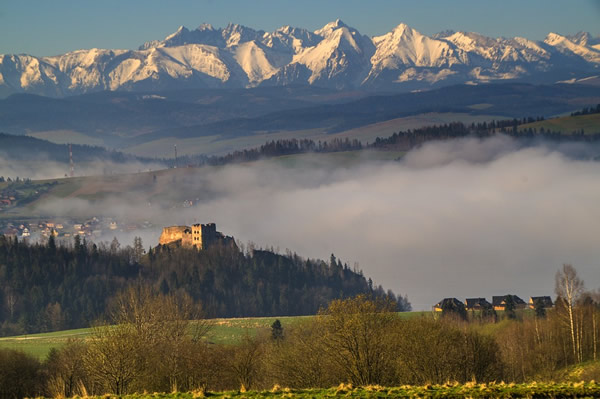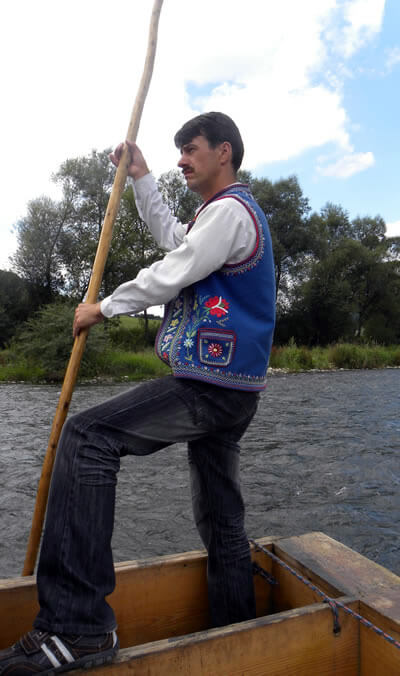Visit the Tatra Mountains of Poland
Experience Highlander Culture
By Barbara Zaragoza

|
|
The magestic Tatra mountains in Poland.
|
Poland has developed quickly as an EU member country, with modern roads and hotels that are as comfortable as any other Western European nation. Despite so many changes, some Polish traditions have continued for generations. In particular, Poles have a penchant for fleeing the cities during most holidays to enjoy the fresh outdoors. Any expat or traveler would be amiss not to do the same. By far, the finest choice is the Tatra Mountains.
The Tatras
Known as Poland’s “Winter Capital” thanks to the abundant ski resorts, during the summertime, a temperate climate brings visitors to the Tatra mountains, and they are curious to experience Polish highlander culture. A drive through the 2-lane roads means passing hamlet after hamlet dotted with haystacks, timber cabins, and breathtaking mountain views. The Tatras boast the highest mountain ranges within the Carpathians. This 1,500-kilometer range forms an arch east and south through Slovakia, Hungary, Ukraine, and Romania. Highlanders of the Tatras are better known as “Gorale,” and live in what today spans southern Poland and northern Slovakia.
A Rafting Adventure
A slice of their culture can be grasped in the Pieniny National Park, where the Polish Association of Pieniny Rafters offers raft rides on the Dunajec River. The ride starts in the small town of Katy and wades for eighteen kilometers along the Polish-Slovak border. The river gorge often narrows, with sheer limestone rock scaling up to two hundred meters high on either side. The raftsman, wearing the traditional blue Highlander vest, asks visitors if the river will turn left or right. The joke is always on those on the rafting adventure, as the river twists give an illusion of turning in one direction but then going in the other. The raftsman leaves visitors off at Szczawnica, where restaurants sit along the harbor. Buses then run regularly back to the starting point.

|
|
Polish rafter. Photo by Barbara Zaragoza.
|
Trekking through History
Denied their past for many years under Communism, there is a pervasive consciousness of history in Poland, and a visit to the Tatras offers a trek back in time. Only a few kilometers north of the raft ride, the Dunajec Castle in the village of Niedzica hangs off a cliff. Initially built in the early 1300s, when this region was part of the Hungarian Kingdom, the castle had many owners throughout the centuries, even being captured by knight robbers. The last owner, a Polish countess, abandoned the castle during World War II. In 1963, the Polish government turned it into a museum. Today, a cobblestone entryway leads to a jail where castle owners once incarcerated prisoners who tried to rob them. Deeper inside, a staircase spirals up to a guard’s sleeping quarters, where skinned animals on the floor and walls take visitors back to the days when hunting was an essential part of daily life.
A courtyard at the castle top overlooks a modern dam built in 1997. On the other side of the reservoir, the ruins of the old Czorzstyn Castle tell a sad story. In 1651, peasant leader Aleksander Kostka Napierski called highlanders to revolt against their nobles. But he and his rebel troops failed perilously, remaining isolated in the Czorzstyn Castle until they were captured and later impaled.
Trekking in Nature
The Poles in the Tatra region have a strong tradition of preserving this natural environment, so hiking trails abound. If you stay at one of the many Bed and breakfasts, the owners will often provide insider recommendations. Our B&B owners not only welcomed us to sit at their backyard bonfire in the evenings for wine and conversation but also drew us a map and suggested we visit the mountain beyond the small village of Kluszkowce.
The town, built by a nobleman in the fourteenth century, has a parish that struts out from the cluster of timber homes. Signs in Kluszkowce’s center point towards a ski lift one kilometer away. Kept open during the summer, visitors go up the lift to the mountain’s peak, where a view stretches past the Dunajec Castle. Although the ski lift can also take visitors back to the mountain’s base, the pleasure lies in wandering through the forests.
Enjoying the Food
At the end of the day, Timer Cabin restaurants serve tasty cuisine in the center of Zakopane, a town well known during the 18th and 19th centuries as a haven for Polish artists. Today, restaurants serve an array of hot and cold soups, including barszcz (beet broth), zurek (sour soup), or chlodnik (cold cucumber-beet soup). Pierogi (filled dumplings) are on every restaurant menu, and they are a large variety, including stuffed with shredded beef, mushrooms, and cabbage or blueberries with cream on top. But in the Tatras, the regional Placek po Zbojnicku (Highlander-style potato cakes) provides a hearty meal consisting of two fried potato pancakes with meat goulash in the middle. Poland also brews its own beers, including Zywiec and Tatra. But here in Zakopane, trying the hot beer with spices or the hot red wine spiked with cinnamon and rum is a pleasure.
Today, Polish Highlander culture blends the beauty of nature, a respect for history, traditional food, and modern conveniences, creating a breathtaking experience.
|
For More Info
How To Get to Zakopane
Trains run from every major city to Zakopane. From Krakow, the train ride takes about three hours. Buses are recommended as the trip takes only about two hours from the Krakow station.
Where to Stay
A little outside Zakopane in the mountains, we found a homey B&B called Villa Toscana that was only €70 for the five of us, including a buffet breakfast. Select from others from the many Bed and Breakfasts in Zakopane.
Check Out
Dunajec Castle in Niedzica
|
Barbara Zaragoza is a Polish-American who lived in Poland during the days right before and after the fall of the Berlin Wall. She currently lives in Naples, Italy, as a freelance writer.
|
